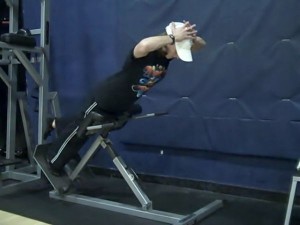 Every now and again I’ll incorporate an exercise into my training program that I fall in love with. Well, I don’t really “fall in love with it”, but it does steal a little piece of my heart . . .
Every now and again I’ll incorporate an exercise into my training program that I fall in love with. Well, I don’t really “fall in love with it”, but it does steal a little piece of my heart . . .
Moving on.
For the past couple of months I have been performing Back Extensions (check out that article for a video and information on how to properly perform the exercise) on my deadlift and/or squat days. The reason I started to perform this exercise was because I wanted the extra glute and hamstring work, but I didn’t want to do anything that would put too much stress on my central nervous system or interfere with my recovery from the main barbell lifts.
It has been years since I performed back extensions with consistency, and my strength on this movement has increased steadily. I started out holding onto a 35 pound dumbbell, and now I’m up to a 65 pound dumbbell.
I’ve also been training later in the day when the gym is quite crowded. So I’ve been growing increasingly annoyed with fighting with the bros for a dumbbell. It was during one of these moments that I thought, “I haven’t done single leg back extensions in years, so I’ll just do those instead so I don’t have to wait for a dumbbell to be available.”
Long story short, I did a few sets of bodyweight single leg back extensions. If you’ve never done these before, prepare to be humbled. Your backside will get lit up quick.
The first time people attempt this variation, they don’t do it properly (as with the traditional two-legged version). I’ll usually let them perform a few reps on their own, and then I’ll provide the proper cues. The end result is usually the same – they “feel” the movement to a much greater extent and generally don’t perform as many reps the next set.
Cues for the Single Leg Back Extension
- Set the pad below your pelvis (this will allow your pelvis to rotate forward which will put the stress primarily on your hamstrings and glutes; your lower back will be worked from holding an isometric contraction)
- Actively push your butt back when you lower your torso toward the ground; just like you push your butt back with a Romanian deadlift, pull through, and kettlebell swing. You should feel a nice stretch in your hamstrings
- Push your hips into the pad, don’t simple pull yourself up with your lower back. Again, this is a similar movement to a kettlebell swing; thrust your hips into the pad and squeeze your glutes hard
- Stop once your body is in a straight line; do not hyperextend your lower back
If you haven’t done the standard two-legged back extension, I don’t recommend jumping straight into the single leg version.
Also, you can adjust the difficulty of the single leg version by manipulating the position of your arms. Hold them at your sides to make the movement easier, and progress to holding them on top of your head (as seen in the video) or even extended overhead.
Here’s a simple progression you can follow from simplest to hardest:
arms at sides => arms crossed at chest => hands on head => arms extended over head => add weight via dumbbell, weight plate, weight vest, or resistance band held below the chin
I should also note that this movement, in my opinion, is best kept in the eight to 20 repetition range.
Now that you have a great posterior chain exercise to try out, allow me to share some awesome articles with you.
Great Reads for You
Squat – by Mike Robertson. Anything you could possibly want and/or need to know about how to squat, you can find in this all inclusive article.
Looking Back at Me. My Body Image Journey – by Marianne Kane. This is an excellent article from my Irish friend. She shares her journey, struggles, and successes when it comes to body image. Most women can probably relate to this one.
Side Effects Include . . . Leanness – by Ryan Andrews of Precision Nutrition. I love this article because it stresses the importance, and benefits, of focusing on the journey of health and fitness.
Excluding the Middle – by Lyle McDonald. In this article, Lyle does an excellent job explaining how people can benefit from not excluding the middle when it comes to training and nutrition.
Big Rocks vs Small Rocks: Key to Dieting & Training Domination – by Roger Lawson. When it comes to your nutrition and training goals, do you focus on big rocks or small rocks?